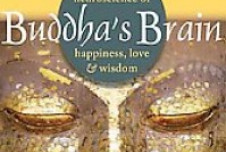We’ve all been there: obsessing over a faux pas we committed at a party, infuriated by an unkind word from a colleague, ruminating over a tough break-up with a spouse or friend. We suffer some misfortune—big or small, real or imagined—and the pain or humiliation sticks with us for hours, days, or even years afterward.
“The mind is like Velcro for negative experiences,” psychologist Rick Hanson is fond of saying, “and Teflon for positive ones.”
 Rick Hanson
Rick Hanson
But it doesn’t have to be this way. Drawing on some of the latest findings from neuroscience, Hanson has spent years exploring how we can overcome our brain’s natural “negativity bias” and learn to internalize positive experiences more deeply—while minimizing the harmful physical and psychological effects of dwelling on the negative.
For years, research has shown that, over time, our experiences literally reshape our brains and can change our nervous systems, for better or worse. Now, neuroscientists and psychologists like Hanson are zeroing in on how we can take advantage of this “plasticity” of the brain to cultivate and sustain positive emotions.
In his recent book, the best-selling Buddha’s Brain, Hanson describes specific practices that can promote lasting joy, equanimity, and compassion—and backs it all up with sound science.
As part of our “Greater Good Podcast” series, Hanson recently spoke with host Michael Bergeisen about some of these very practical, research-based steps we can all take to rewire our brains for lasting happiness.
You can listen to the interview here, and we encourage you to subscribe to the podcast series through iTunes. Below we present a condensed version of the discussion.
Hanson will also be elaborating on many of these ideas as a speaker at the Greater Good Science Center ‘s October 22 seminar, “Building Gratitude,” which will be on the UC Berkeley campus. Click here to learn more and register.
Michael Bergeisen: Most of us think of the human brain as either unchanging or losing power and strength as we get older, but the central theme of your new book is that we each have the capacity to change our brain for the better to make ourselves happier, more peaceful, and more kind. How can we do this exactly?
Rick Hanson: We’ve all known as we’ve gone through life that our minds have changed. In other words, we’ve learned things as we go through life, we picked up new skills, we’ve had experiences, we remember them. All that mental activity means that we’ve changed our brain. That’s not breaking news. In other words, it’s long been known that as the mind changes, the brain must be changing as well.
What is breaking news is that in the last 20 years, the scientific understanding of the brain has literally doubled. And that has given us much more clarity about the linkages between the mind and the brain, which then gives us this amazing possibility to change our brain to change our mind—so that we feel better, we’re happier, we’re less prone to suffering, we’re kinder, we’re better to people around us, we’re more effective at home and work, and we have more sense of a kind of inner peace and connectedness with all things.
MB: Can you give us an example of a practice that has this effect on the mind and hence the brain?
RH: Whenever you are aware of your own body sensations. For example, when you pay attention to your breathing, or if you golf, or if you’re a dancer, or if you do something like yoga, or Tai Chi, or if you meditate—in all those cases, you’re paying attention to the internal sensations of your body. Well, as it turns out, a part of the brain called the insula—there are two of them actually—track the internal state of the body, which means also that they’re intimately involved in sensing your feelings.
Research has shown that as people activate their insula more, such as through meditation, the insula actually gets thicker. In other words, neurons make more and more connections with each other, which actually measurably thickens your insula.
MB: And what is the benefit of that?
RH: It’s a demonstration that they are making more connections with each other. So as a result, people then become more in touch with themselves, which is good. But even beyond that, research has shown that the insula is also crucial for empathy. Because when we get a sense of the emotions of other people, we actually light up the same neural circuits in our own brain—they light up as if we’re accessing those feelings ourselves.
So the point is, that if you can strengthen the insula, that will both make you more able to be aware of yourself and also help you be more empathic toward others.
The classic line in neural psychology is, “As neurons fire together they wire together.” The seemingly immaterial and ephemeral flow of the thoughts and feelings through your mind leaves behind traces in your brain. So the takeaway point is to be very thoughtful about what you think about all day long. A lot of us think about crud all day long. We’re worrying about this, we’re planning that, we’re obsessing over something bad that might happen that hasn’t even happened, whatever. Or we’re thinking about what a loser we are, how we just never get anywhere in life, or people don’t love us, or we get mistreated—and there’s a place for that if it’s productive.
But much of the time, we’re just running those movies in the mental simulator. The problem is, as we run those movies, they’re leaving behind traces of neural structure that are negativistic, depressive, pessimistic, and very self-critical.
MB: So we initially talked about the more positive aspects of the brain. Now you’ve started identifying parts of the brain that have a more negative slant. And in your book, you do talk about this negativity bias in our brains. Can you describe that a bit more?

RH: Our ancestors, the ones who lived to pass on their genes, got better and better and better at making a crucial decision many times a day about whether to approach something or avoid it. Approach the pleasant, avoid the unpleasant. Approach the carrot, duck the stick.
Alright, now the problem is that sticks are much more important to pay attention to in the wild than carrots because if you miss a carrot today, you’ll get another chance at one tomorrow, but if you don’t avoid a stick today—Wham!—you’re not gonna get a crack at a carrot tomorrow.
So we’ve developed what’s called in science a “negativity bias,” which means that the brain, to help us survive, preferentially looks for, reacts to, stores, and then recalls negative information over positive information. For example, there’s a pretty famous finding in the realm of relationship psychology from John Gottman, of the University of Washington, that it takes at least five positive interactions to make up for just one negative one. In other words, in effect, a negative interaction in an important relationship is five times more powerful than a positive interaction. That’s an example of the negativity bias at work.
So then the really interesting question becomes: How can you overcome it? That’s why, for me, taking in the good is an absolutely crucial skill to develop, and a wonderful way to balance this unfair tilt embedded in your own nervous system.
MB: What do you mean by “taking in the good”?
RH: The brain is like Velcro for negative experiences but Teflon for positive experiences.
For most of us, as we go through the day, most of the moments in life are either neutral or positive. The problem is that neutral or positive moments get remembered with standard memory systems, which is to say they’re mostly in-and-out. But negative experiences are instantly registered and intensely focused on, based on the negativity bias of the brain. Then they get stored in what’s called “implicit memory”—not so much memory for events, like what I did on my summer vacation, but rather the feeling of being alive. And that implicit memory bank gets shaded in a darker and darker way by the slowly accumulating residue of negative experiences.
To counteract that, we need to actively build up positive implicit memories to balance this unfair accumulation of negative implicit memories. And the way to do that is three steps for sure with an optional fourth step.
The first step is to turn positive events into positive experiences. All kinds of good things happen in our daily life that we hardly notice at all, and if we do, we don’t feel it. Someone pays us a compliment, we hardly pay attention to it, or we deflect it. So instead of thatm you turn positive events into positive experiences.
Second, really savor it. In other words, the way to remember something is to make it intense, felt in the body, and lasting. That’s how we give those neurons lots and lots time to fire together so they start wiring together. So rather than noticing it and feeling good for a couple of seconds, stay with it. Relish it, enjoy it, for 10, 20, or 30 seconds, so it really starts developing neural structure.
The third step is to sense and intend that this positive experience is sinking into you and becoming a part of you. In other words, it’s becoming woven into the fabric of your brain and yourself.
For bonus points, if you’re so inclined, it’s often very powerful to take a current positive experience and have it kind of go down inside to an old place of pain. Do not do this if you have a trauma history and you get flooded if you think about old pain. The method is to have the old painful material be in the background of awareness while the current positive experience that is its antidote is prominent and strong in a foreground of awareness, and hold both those things in mind for 10 or 20 or 30 seconds straight. If you can’t do that, don’t worry about this fourth step. But if you can do that, wow, this fourth step is really powerful. Honestly over many years, it’s how I filled my own hole in the heart.
MB: Your book is filled with practices that people can try to boost their feelings of love and happiness and equanimity. Do you use any of these practices on a regular basis?
RH: Oh yeah. My wife wishes I used more, but anyway.
MB: Can you identify one and perhaps describe the effect that you’ve seen it have on your mind and brain?
RH: Yeah, I’ll mention two, actually.
One is the importance of focusing on positive experiences, because of the negativity bias of the brain, and also because positive experience has so many benefits. It’s so good for the immune system. It’s so good for concentration. Positive emotional states help steady the mind for a complex reason involving dopamine. So in daily life, I look for positive emotion and I really try to allow it to be there and to kind of sink into it, to welcome it.
Second, I’ve really come to appreciate how extremely sensitive we are to threat. If you think about it, in life there are two big mistakes you can make: You can either think there is a tiger there when there is not. Or you can think there is no tiger, but there really is one. Of those two mistakes, which one do most people make most the time? It’s the first one. We think there’s a tiger there when there really is no tiger. Or it’s a baby tiger, or it’s a paper tiger, or it’s a tiger in chains. And we go through life feeling threatened all the time.
So I’ve become very alert to needless threat. I don’t want to make the second mistake—in other words, I want to see clearly and be discerning about what is truly a threat over there. But I don’t want to be bamboozled or misguided either by my own mental processes or by external messages into thinking that there’s a threat there when there really isn’t one.
And related to that, I’ve also become much more thoughtful about not being threatening to other people needlessly. I don’t mean walking on egg shells, avoiding telling the truth when it’s appropriate and useful and all the rest of that. But what I do mean is being thoughtful about how I give people an alarm signal sometimes when I don’t really mean to.
MB: Let me come back to another very concrete aspect of your book, and that’s something that you call “the two darts of suffering.” Can you talk a little bit about what those two darts are and whether they’re tied to our nervous system in any way?
RH: Sure. Well, the metaphor is the Buddha. He said that things happen in life that are painful and difficult. At a physical level, we’re all exposed to aging and disease and death, and because we’re intensely social animals who love, we’re also exposed to sorrow when people we love die or are threatened or are in pain. Those are the first darts of life; you can’t escape them.
Then the Buddha pointed out that we compound the pain through self-inflicted wounds, in other words, that we throw “second darts” at ourselves. For example, we get upset that we’re in pain or somebody says something cruel to us, which is a first dart, and it pierces us and hurts, but then we brood over it for the rest of the day, inflicting all kinds of second darts upon ourselves.
When a first dart lands, it’s really important to try to automatically start activating the parasympathetic wing of the nervous system, because first darts trigger the stress response—the “fight or flight” wing of the nervous system. So as much as you can, start trying to get automatic around taking deep breaths, calming yourself down, imagining that you’re safe, or as safe as possible, bringing to mind other resources, reminding yourself you’ve gotten through these situations in the past, calling to mind positive emotions that are the antidote to whatever has happened right then and there—whatever works for you.
It’s deceptively simple, but if one takes in the good a handful of times everyday, related to really small things, that’s going to make a permanent change in your nervous system, probably in a matter of days.






Comments
This is a fantastic website and I can not recommend you guys enough. Full of useful resource and great layout very easy on the eyes. Please do keep up this great work. cs 1.6 download
jibran | 12:50 am, October 18, 2011 | Link
This is one of the most fantastic topics that
excites me a lot.
Some neurophysiologists believe that “happiness
centers”
have an impact on all the fundamental processes
in the brain.
A pleasure came last in evolution as a kind of
reward that
could induce our brain to make the right decision.
It plays a
prominent role in the specialization of the cerebral
hemispheres. For example, when we listen to the
music, the
right hemisphere collects the information about
the rhythm,
rhyme, melody, and the left hemisphere - the
meaning of
sentences, syntax, message. The right hemisphere
of the
brain very realistically assess what is happening
with us and
around us. On the contrary the left one has a
tendency to
“swing in the clouds” and loves to manipulate the
information that reaches us.
kredyt _hipoteczny
Kredyt Hipoteczny | 8:41 pm, October 22, 2011 | Link
That´s a very interesting subject.
Credito Pessoal | 9:02 am, October 24, 2011 | Link
Great article and information Michael. I am always searching for more info. on Neurology. The subject has always interested me to find out more ways to improve. You have given great detail as well as the mention to check out the Podcast. Will do. thanks again
Ageing Well | 1:41 am, November 19, 2011 | Link